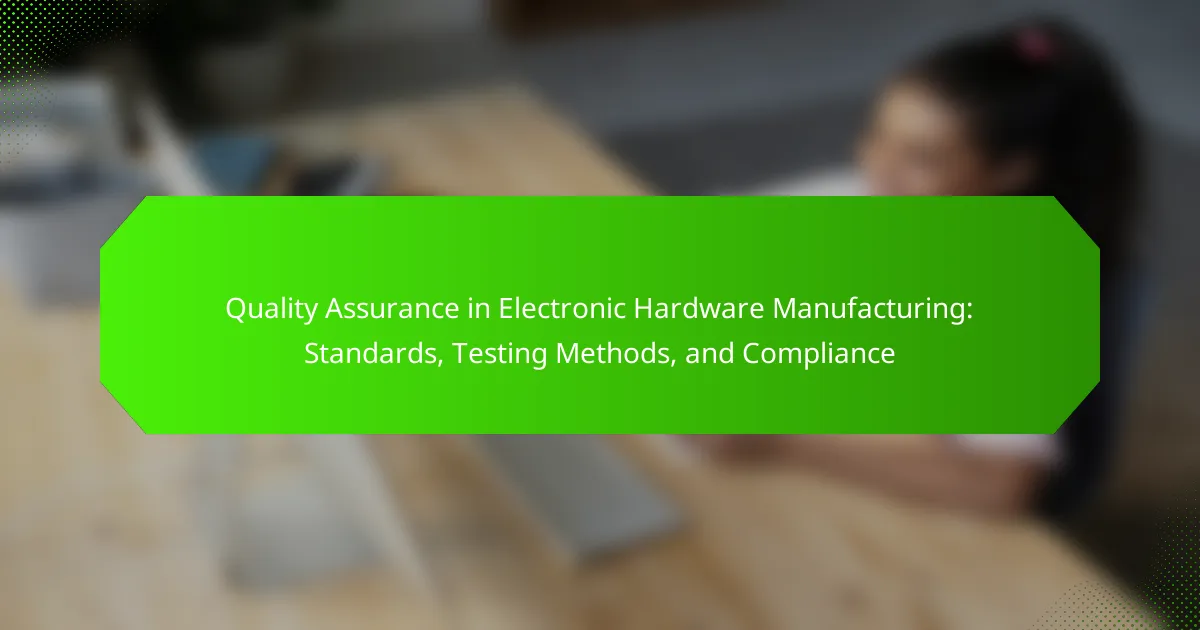Quality assurance in electronic hardware manufacturing is a systematic process that ensures products meet specified requirements and industry standards. This process includes activities such as testing, inspection, and quality control measures, which are essential for identifying defects and enhancing product reliability and performance. Key standards guiding these practices include ISO 9001, IPC standards, and MIL-STD specifications, which help manufacturers achieve compliance and improve operational efficiency. Various testing methods, such as functional, stress, reliability, performance, and compliance testing, play a crucial role in validating product quality and ensuring adherence to industry regulations. Overall, effective quality assurance minimizes errors and contributes to customer satisfaction in the electronic hardware sector.

What is Quality Assurance in Electronic Hardware Manufacturing?
Quality assurance in electronic hardware manufacturing is a systematic process ensuring that products meet specified requirements and standards. It involves various activities such as testing, inspection, and quality control measures. These activities help identify defects and ensure reliability and performance. Quality assurance aims to minimize errors and enhance product quality throughout the manufacturing process. Industry standards, such as ISO 9001, guide these practices. Compliance with these standards is essential for market acceptance and customer satisfaction. Effective quality assurance can lead to reduced costs and improved operational efficiency.
Why is Quality Assurance important in Electronic Hardware Manufacturing?
Quality Assurance is crucial in Electronic Hardware Manufacturing to ensure product reliability and safety. It helps identify defects early in the production process. This reduces waste and lowers costs associated with recalls and repairs. Quality Assurance also ensures compliance with industry standards and regulations. For instance, adherence to ISO 9001 can enhance customer satisfaction. Furthermore, consistent quality improves brand reputation and market competitiveness. Studies show that companies with robust Quality Assurance systems see a 30% reduction in production errors. Hence, effective Quality Assurance is integral to operational success in this sector.
What are the key objectives of Quality Assurance?
The key objectives of Quality Assurance are to ensure product quality and enhance customer satisfaction. Quality Assurance aims to identify defects and prevent them in the manufacturing process. It establishes standardized procedures to maintain consistency in production. Continuous improvement is also a critical objective, focusing on refining processes and reducing waste. Compliance with industry standards is essential to meet regulatory requirements. Training and development of staff are necessary to uphold quality practices. Ultimately, Quality Assurance seeks to build trust and reliability in products.
How does Quality Assurance impact product reliability?
Quality Assurance (QA) significantly enhances product reliability. QA processes systematically identify and mitigate defects during production. This proactive approach ensures that products meet specified standards before reaching consumers. Effective QA reduces the likelihood of failures in the field. According to a study by the American Society for Quality, companies with robust QA practices see a 30% reduction in product returns. Furthermore, consistent testing and validation during manufacturing leads to improved performance and longevity. Overall, QA is essential for maintaining high reliability in electronic hardware products.
What are the main components of Quality Assurance in this context?
The main components of Quality Assurance in electronic hardware manufacturing include standards, testing methods, and compliance processes. Standards provide a framework for quality expectations and benchmarks. Testing methods involve various techniques to evaluate product performance and reliability. Compliance processes ensure adherence to regulatory and industry standards. These components work together to minimize defects and enhance product quality. Effective implementation leads to improved customer satisfaction and reduced costs associated with failures.
What role do standards play in Quality Assurance?
Standards play a critical role in Quality Assurance (QA) by providing a framework for consistent quality measurements. They establish benchmarks for performance, safety, and reliability in electronic hardware manufacturing. Standards guide organizations in developing processes that meet industry expectations. Compliance with these standards ensures that products are tested and validated effectively. For instance, ISO 9001 outlines requirements for a quality management system. Adhering to such standards minimizes defects and enhances customer satisfaction. Additionally, standards facilitate communication between stakeholders by providing a common language. They also help in regulatory compliance, reducing risks associated with non-conformance. Thus, standards are essential for maintaining high-quality products and processes in QA.
How do testing methods contribute to Quality Assurance?
Testing methods are essential for Quality Assurance (QA) in electronic hardware manufacturing. They identify defects and ensure products meet specified standards. Testing methods include functional testing, reliability testing, and performance testing. Each method targets specific attributes of the hardware. For instance, functional testing verifies that the product operates according to design specifications. Reliability testing assesses the product’s durability over time. Performance testing evaluates the efficiency and speed of the hardware. Implementing these methods reduces the risk of failures in the field. According to a study by the International Journal of Quality & Reliability Management, effective testing can decrease product returns by up to 30%. This demonstrates the significant impact of testing on overall product quality and customer satisfaction.

What Standards are Applied in Quality Assurance for Electronic Hardware?
The standards applied in quality assurance for electronic hardware include ISO 9001, IPC standards, and MIL-STD specifications. ISO 9001 focuses on quality management systems to ensure consistent quality. IPC standards provide guidelines for electronics manufacturing processes, including assembly and testing. MIL-STD specifications are military standards that ensure reliability and performance in electronic components. These standards help manufacturers meet customer requirements and regulatory compliance. They also enhance product reliability and reduce defects.
What are the most recognized Quality Standards in the industry?
The most recognized quality standards in the electronic hardware manufacturing industry include ISO 9001, IPC-A-610, and ISO/IEC 17025. ISO 9001 sets the framework for quality management systems. It emphasizes continuous improvement and customer satisfaction. IPC-A-610 provides criteria for the acceptability of electronic assemblies. It covers workmanship standards for soldering and assembly processes. ISO/IEC 17025 specifies requirements for testing and calibration laboratories. It ensures the competence of laboratories to produce valid and reliable results. These standards are widely adopted and help ensure product quality and reliability in the industry.
How does ISO 9001 influence Quality Assurance practices?
ISO 9001 significantly influences Quality Assurance practices by establishing a framework for consistent quality management systems. It emphasizes customer satisfaction, process approach, and continuous improvement. Organizations implementing ISO 9001 must document procedures and maintain records, ensuring transparency and accountability. The standard requires regular audits and reviews, fostering a culture of quality within the organization. Compliance with ISO 9001 often leads to enhanced operational efficiency and reduced waste. Research indicates that companies adhering to ISO 9001 see improvements in product quality and customer trust. This standard serves as a benchmark for best practices in Quality Assurance across various industries, including electronic hardware manufacturing.
What is IPC and how does it relate to electronic hardware?
IPC stands for the Institute of Printed Circuits. It is a global trade association for the electronics industry. IPC develops standards for the design, manufacturing, and assembly of electronic hardware. These standards ensure quality and reliability in electronic products. Compliance with IPC standards helps manufacturers achieve consistent quality. It also facilitates communication among industry stakeholders. IPC standards cover various aspects, including materials, processes, and testing methods. Adhering to these standards is crucial for quality assurance in electronic hardware manufacturing.
How do these standards ensure compliance?
Standards ensure compliance by providing a clear framework for quality assurance in electronic hardware manufacturing. They outline specific requirements that manufacturers must meet to ensure product reliability and safety. These standards include guidelines for testing methods, materials, and processes. Compliance with these standards is often verified through regular audits and inspections. Certification bodies assess manufacturers against these standards to ensure adherence. Non-compliance can lead to penalties or loss of certification. Historical data shows that adherence to standards reduces product failures and enhances customer satisfaction. For example, ISO 9001 is widely recognized for improving quality management systems.
What are the consequences of non-compliance with Quality Standards?
Non-compliance with quality standards can lead to significant consequences. These consequences include product recalls, which can cost companies millions. Additionally, non-compliance may result in legal penalties, including fines and lawsuits. Companies may also face damage to their reputation, leading to loss of customer trust. Furthermore, there can be operational disruptions, affecting production timelines and efficiency. In severe cases, regulatory agencies may impose restrictions on a company’s ability to operate. Studies show that organizations with stringent quality compliance experience fewer failures and greater customer satisfaction. Therefore, adhering to quality standards is crucial for long-term success in electronic hardware manufacturing.
How can organizations maintain compliance over time?
Organizations can maintain compliance over time by implementing continuous monitoring and regular audits. They should establish a compliance management system that includes policies, procedures, and training for employees. Regular updates to compliance programs are essential to adapt to changing regulations. Organizations must document compliance efforts thoroughly to provide evidence during audits. Engaging with compliance experts can help identify gaps and improve processes. Additionally, using technology solutions can streamline compliance tracking and reporting. Consistent communication about compliance requirements fosters a culture of accountability. Finally, organizations should review and revise their compliance strategies periodically to ensure effectiveness.

What Testing Methods are Used in Quality Assurance?
Quality assurance in electronic hardware manufacturing employs several testing methods. These methods include functional testing, which verifies that the product operates according to specifications. Another method is stress testing, which assesses how the product performs under extreme conditions. Reliability testing evaluates the lifespan and durability of the hardware. Performance testing measures the speed and efficiency of the product. Additionally, compliance testing ensures that the hardware meets industry standards and regulations. Each method plays a crucial role in identifying defects and ensuring quality.
What types of testing methods are commonly employed?
Commonly employed testing methods in electronic hardware manufacturing include functional testing, in-circuit testing, and environmental testing. Functional testing verifies that the device operates according to specifications. In-circuit testing checks individual components on a circuit board for defects. Environmental testing assesses the hardware’s performance under various conditions, such as temperature and humidity. These methods ensure reliability and compliance with industry standards. For instance, functional testing can reveal design flaws early in the production process, which is crucial for quality assurance.
How does functional testing differ from stress testing?
Functional testing verifies that a system performs its intended functions correctly. It focuses on checking specific functionalities against requirements. Stress testing, on the other hand, evaluates how a system behaves under extreme conditions. It aims to identify the breaking point of the system. Functional testing is concerned with expected behavior, while stress testing examines performance under unusual loads. For example, functional testing might check if a device powers on and responds to user inputs. In contrast, stress testing would assess how the device performs when subjected to high temperatures or excessive data processing. Both testing types are essential for ensuring quality in electronic hardware manufacturing.
What is the significance of reliability testing?
Reliability testing is crucial in ensuring electronic hardware meets performance standards over time. It assesses the likelihood that a product will function without failure under specified conditions. This testing identifies potential defects and weaknesses before mass production. By uncovering issues early, manufacturers can implement corrective actions, reducing costly recalls. Reliability testing also enhances customer satisfaction by delivering dependable products. According to a study by the IEEE, products with robust reliability testing have a 30% lower failure rate in the field. This underscores its importance in maintaining quality assurance in electronic hardware manufacturing.
How do testing methods ensure product quality?
Testing methods ensure product quality by systematically evaluating products against defined standards. These methods include functional testing, reliability testing, and performance testing. Functional testing verifies that all features operate correctly under specified conditions. Reliability testing assesses how a product performs over time and under stress. Performance testing measures the product’s efficiency and effectiveness in real-world scenarios. Each method identifies defects or areas for improvement before products reach consumers. Statistical process control is often used to monitor quality during manufacturing. According to the International Organization for Standardization (ISO), adherence to testing standards significantly reduces the risk of product failure.
What metrics are used to evaluate testing effectiveness?
Key metrics used to evaluate testing effectiveness include defect density, test coverage, and mean time to failure. Defect density measures the number of defects identified per unit of size, often expressed as defects per thousand lines of code. Test coverage assesses the percentage of code or requirements tested, indicating how thoroughly the testing process has been conducted. Mean time to failure quantifies the average time between failures during testing, reflecting reliability and performance. These metrics provide insights into the quality and reliability of electronic hardware, ensuring compliance with industry standards.
How can organizations improve their testing processes?
Organizations can improve their testing processes by implementing standardized testing protocols. Standardization reduces variability and increases reliability in testing outcomes. Utilizing automated testing tools enhances efficiency and accuracy in identifying defects. Regular training for testing personnel ensures they are up-to-date with the latest methodologies. Adopting a feedback loop from testing results informs continuous improvement efforts. Integrating risk assessment into testing processes helps prioritize critical areas. Collaborating with cross-functional teams fosters a comprehensive understanding of product requirements. These strategies lead to higher quality products and reduced time to market.
What are best practices for implementing Quality Assurance in manufacturing?
Best practices for implementing Quality Assurance in manufacturing include establishing clear quality standards and procedures. These standards should align with industry regulations and customer requirements. Regular training for employees on quality practices is essential. This training ensures that all team members understand their roles in maintaining quality. Implementing a robust inspection and testing process is also critical. This process should occur at various stages of production to identify defects early. Utilizing statistical process control can help monitor production quality in real-time. Documenting all quality assurance activities supports transparency and accountability. Continuous improvement practices should be integrated to enhance quality over time. These steps collectively contribute to a more efficient and reliable manufacturing process.
Quality Assurance in Electronic Hardware Manufacturing is a systematic process designed to ensure products meet specific requirements and industry standards. This article covers the importance of quality assurance, key objectives, and the impact of various testing methods on product reliability. It also highlights recognized quality standards such as ISO 9001 and IPC, explaining their role in compliance and overall product quality. Additionally, the article discusses best practices for implementing effective quality assurance processes within manufacturing environments, emphasizing continuous improvement and employee training to enhance operational efficiency.



